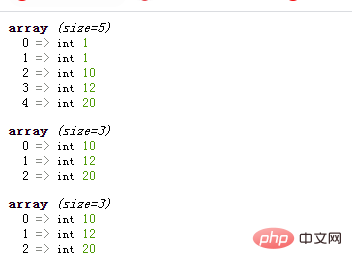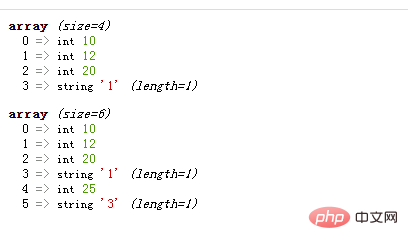 Backend Development
Backend Development
 PHP Tutorial
PHP Tutorial
 Tips for learning PHP arrays and using functions to insert elements (2)
Tips for learning PHP arrays and using functions to insert elements (2)
Tips for learning PHP arrays and using functions to insert elements (2)
In the previous article "PHP Array Learning Skillful Use of Functions to Insert Elements (1)", we introduced two methods of adding new elements to the array. Use array_unshift() to add new elements to the array. To insert a new element at the beginning, use array_push() to insert a new element at the end of the array. Today we will continue to introduce the method of inserting new elements into the PHP array, and introduce two methods to you.
This article uses code examples to introduce the array_pad() and array_splice() functions to see how they insert new elements.
1. The array_pad() function inserts new elements into the array
array_pad($array,$size,$value) The function can insert a certain key value $value into the array $array, thereby filling the array to the specified length $size. (The $size parameter can be understood as the final number of elements in the array, that is, the length of the array after the insertion operation).
Let’s take a closer look at the following example:
<?php $arr=array(10,12,20); $result =array_pad($arr,5,1); var_dump($result); ?>
As can be seen from array_pad($arr,5,1), $size## The value of # is 5, then there are 5 elements in the array after the insertion operation; and there are 3 elements in the original array, then only 2 elements need to be inserted. And because the inserted value $value is 1, you only need to insert 2 elements with the value "1". Therefore, the output result is:

$size parameter. The
$size parameter has three values: if
- is a positive number, elements will be inserted at the end of the array; If
- is a negative number, insert the element at the beginning of the array;
- If its absolute value is less than or equal to the length of the
$array
array, no element will be inserted. Insert operation.
<?php $arr=array(10,12,20); $result =array_pad($arr,-5,1); var_dump($result); $result =array_pad($arr,3,1); var_dump($result); $result =array_pad($arr,2,1); var_dump($result); ?>

$value can also be an array, that is Insert an entire array, and the original array will become a two-dimensional array.
<?php
header("Content-type:text/html;charset=utf-8");
$arr=array(10,12,20);
$result =array_pad($arr,-5,array("张三",25,"男"));
var_dump($result);
?>
2. The array_splice() function inserts new elements into the array
array_splice($array,$start,$length,$value)The function is a powerful function that can be used to delete array elements, replace array elements, and also insert arrays element (just set the parameter $length to 0).
$length=0, then the parameter $start can specify the position (subscript) to start inserting, and the parameter $value can The insertion value can be specified (if there are multiple values, it needs to be set as an array).
<?php
header("Content-type:text/html;charset=utf-8");
$arr1=array(10,12,20);
array_splice($arr1,0,0,"1");
var_dump($arr1);
$arr2=array(10,12,20);
array_splice($arr2,0,0,array("1",25,"3"));
var_dump($arr2);
?>
$start=0, the $value values will be inserted into the beginning of the array in order. So what do you do if you want to insert an element at the end of the array?
$start to "array length value", that is, count($arr).
<?php
header("Content-type:text/html;charset=utf-8");
$arr1=array(10,12,20);
array_splice($arr1,count($arr1),0,"1");
var_dump($arr1);
$arr2=array(10,12,20);
array_splice($arr2,count($arr2),0,array("1",25,"3"));
var_dump($arr2);
?>
PHP function array array function video explanation, come and learn!
The above is the detailed content of Tips for learning PHP arrays and using functions to insert elements (2). For more information, please follow other related articles on the PHP Chinese website!

Hot AI Tools

Undresser.AI Undress
AI-powered app for creating realistic nude photos

AI Clothes Remover
Online AI tool for removing clothes from photos.

Undress AI Tool
Undress images for free

Clothoff.io
AI clothes remover

Video Face Swap
Swap faces in any video effortlessly with our completely free AI face swap tool!

Hot Article

Hot Tools

Notepad++7.3.1
Easy-to-use and free code editor

SublimeText3 Chinese version
Chinese version, very easy to use

Zend Studio 13.0.1
Powerful PHP integrated development environment

Dreamweaver CS6
Visual web development tools

SublimeText3 Mac version
God-level code editing software (SublimeText3)

Hot Topics
 1672
1672
 14
14
 1428
1428
 52
52
 1332
1332
 25
25
 1276
1276
 29
29
 1256
1256
 24
24
 PHP: A Key Language for Web Development
Apr 13, 2025 am 12:08 AM
PHP: A Key Language for Web Development
Apr 13, 2025 am 12:08 AM
PHP is a scripting language widely used on the server side, especially suitable for web development. 1.PHP can embed HTML, process HTTP requests and responses, and supports a variety of databases. 2.PHP is used to generate dynamic web content, process form data, access databases, etc., with strong community support and open source resources. 3. PHP is an interpreted language, and the execution process includes lexical analysis, grammatical analysis, compilation and execution. 4.PHP can be combined with MySQL for advanced applications such as user registration systems. 5. When debugging PHP, you can use functions such as error_reporting() and var_dump(). 6. Optimize PHP code to use caching mechanisms, optimize database queries and use built-in functions. 7
 PHP and Python: Comparing Two Popular Programming Languages
Apr 14, 2025 am 12:13 AM
PHP and Python: Comparing Two Popular Programming Languages
Apr 14, 2025 am 12:13 AM
PHP and Python each have their own advantages, and choose according to project requirements. 1.PHP is suitable for web development, especially for rapid development and maintenance of websites. 2. Python is suitable for data science, machine learning and artificial intelligence, with concise syntax and suitable for beginners.
 PHP in Action: Real-World Examples and Applications
Apr 14, 2025 am 12:19 AM
PHP in Action: Real-World Examples and Applications
Apr 14, 2025 am 12:19 AM
PHP is widely used in e-commerce, content management systems and API development. 1) E-commerce: used for shopping cart function and payment processing. 2) Content management system: used for dynamic content generation and user management. 3) API development: used for RESTful API development and API security. Through performance optimization and best practices, the efficiency and maintainability of PHP applications are improved.
 The Enduring Relevance of PHP: Is It Still Alive?
Apr 14, 2025 am 12:12 AM
The Enduring Relevance of PHP: Is It Still Alive?
Apr 14, 2025 am 12:12 AM
PHP is still dynamic and still occupies an important position in the field of modern programming. 1) PHP's simplicity and powerful community support make it widely used in web development; 2) Its flexibility and stability make it outstanding in handling web forms, database operations and file processing; 3) PHP is constantly evolving and optimizing, suitable for beginners and experienced developers.
 PHP and Python: Different Paradigms Explained
Apr 18, 2025 am 12:26 AM
PHP and Python: Different Paradigms Explained
Apr 18, 2025 am 12:26 AM
PHP is mainly procedural programming, but also supports object-oriented programming (OOP); Python supports a variety of paradigms, including OOP, functional and procedural programming. PHP is suitable for web development, and Python is suitable for a variety of applications such as data analysis and machine learning.
 PHP vs. Other Languages: A Comparison
Apr 13, 2025 am 12:19 AM
PHP vs. Other Languages: A Comparison
Apr 13, 2025 am 12:19 AM
PHP is suitable for web development, especially in rapid development and processing dynamic content, but is not good at data science and enterprise-level applications. Compared with Python, PHP has more advantages in web development, but is not as good as Python in the field of data science; compared with Java, PHP performs worse in enterprise-level applications, but is more flexible in web development; compared with JavaScript, PHP is more concise in back-end development, but is not as good as JavaScript in front-end development.
 PHP and Python: Code Examples and Comparison
Apr 15, 2025 am 12:07 AM
PHP and Python: Code Examples and Comparison
Apr 15, 2025 am 12:07 AM
PHP and Python have their own advantages and disadvantages, and the choice depends on project needs and personal preferences. 1.PHP is suitable for rapid development and maintenance of large-scale web applications. 2. Python dominates the field of data science and machine learning.
 PHP: Handling Databases and Server-Side Logic
Apr 15, 2025 am 12:15 AM
PHP: Handling Databases and Server-Side Logic
Apr 15, 2025 am 12:15 AM
PHP uses MySQLi and PDO extensions to interact in database operations and server-side logic processing, and processes server-side logic through functions such as session management. 1) Use MySQLi or PDO to connect to the database and execute SQL queries. 2) Handle HTTP requests and user status through session management and other functions. 3) Use transactions to ensure the atomicity of database operations. 4) Prevent SQL injection, use exception handling and closing connections for debugging. 5) Optimize performance through indexing and cache, write highly readable code and perform error handling.



